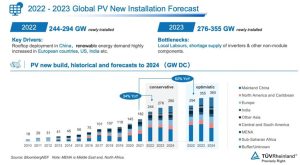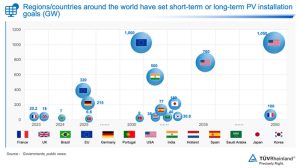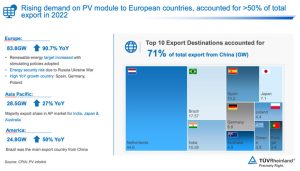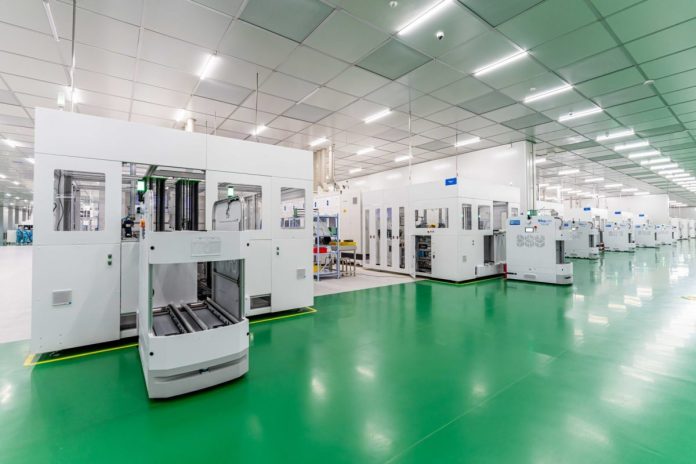TÜV Rheinland has held a ‘Global PV Buyers’ Workshop’, inviting some 20 representatives from the industry’s downstream players to take part. These included investors such as Brookfield Renewable, BayWa, Engie, TotalEnergies and Lightsource BP, and companies mainly engaged in development and operations such as ACWA Power, Bouygues and ECADI, the idea being to share their thinking from different perspectives on module quality and procurement strategies.
“Our company purchased TOPCon modules last year, and have recently purchased more,” Yanyee Chen, Technical Representative at Atlas told PV-Tech.
Chen Liang, Project Procurement Manager for APAC at Lightsource BP agreed with this strategy, adding: “One of the major considerations for developers is ROI. A quick way to increase ROI and reduce levelised cost of energy (LCOE) is to adopt new technologies and make innovations. To maximise the technological payback it is better to adopt earlier than other developers.”
It has been reported that Lightsource BP currently deploys TOPCon modules for some of its projects and this is not the first time that the company has been among the earliest to choose cutting-edge technology, already reaping the benefits of its purchase of bifacial modules.
Compared with Atlas and Lightsource BP, Engie and TotalEnergies have taken a more cautious and conservative approach, but they too have started purchasing n-type modules.
The trend of switching from p-type to n-type modules is not only gathering momentum on the PV manufacturing side, but also gradually being followed by end users. Facing the conversion in technology and capacity, as well as the emergence of new products and players, major developers, buyers and EPCs each have different considerations, which provides module suppliers at different levels with opportunities to sell and grow.
 Analytic report of Global PV Buyers’ Workshop. Source: TÜV Rheinland
Analytic report of Global PV Buyers’ Workshop. Source: TÜV Rheinland
N-type module selection: Quality, Delivery, Supply Chain considerations
Whether for TOPCon, HJT or IBC, new technologies often require new production lines. Power plant developers and investors don’t have other choices, and they also have to take risks.
Ling Jin from TotalEnergies commented: “Some of the suppliers we work with have shifted a large portion of their production capacity quota to TOPCon, so we are also switching from p-type to n-type for the capacity we have contracted. In fact, n-type modules first appeared a couple of years ago and we knew then that the manufacturers would move in this direction. However, considering corporate culture, financing needs and risk assessment, we have been relatively cautious. Of course, we remain open to new technologies and fully welcome innovation so, with the right level of quality control, we have already planned for some projects to use TOPCon.”
“New technologies will inevitably bring new products and new risks. Since we can’t avoid this, we will evaluate each new product and test it in small quantities first. As for how fast to adopt a new product, I think every buyer has its own timetable in mind.” Atlas’ Yanyee Chen added that, while it is necessary to show initiative, it is also important to find the balance of not being the “guinea pig” or the very last one to move.
He went on: “In addition, we need the assistance of our dealers and partners. In this way, we can learn more about new production lines at different module factories and bases, their management, production teams, or even operators, because even if from the same brand and factory, the product quality can be different. With all the information to hand, we will then select suitable products to reduce our risk.”
Of course, there is another pain point for some module buyers. If they do not have enough knowledge about the new products at the outset, or do not purchase enough products to carry out meaningful testing, they are sometimes unable to get the answers they need to solve their problems. Therefore more effective verification methods are needed.
Zhang Yonggang from Engie China said: “For us, one of the effective ways to avoid risk is to seek professional support from a third party such as TÜV Rheinland. Whether it is production line evaluation or testing and verification of product quality, reliability and stability, TÜV Rheinland always has proven methods. We pay special attention to technical contracts and quality control. It is a method we frequently use when introducing new technologies and new suppliers.”
In this regard, Ju Shangshang, Department Manager of Solar PV Systems at TÜV Rheinland Greater China, Solar & Commercial Products, explained: “Technologies are upgraded at a very fast pace. When serving purchasers, we will consider more targeted verification methods with faster feedback. We test new products within the shortest time possible, so as to integrate into the market faster.”
TÜV Rheinland provides customised solutions based on each company’s requirements. While providing testing and certification services, it delivers feedback at different levels and adds extra value for customers. For example, new problems often emerge when testing new technologies and products, thus additional verification methods and communications are required to provide customised solutions, strengthen the quality control of suppliers during manufacturing, identify problems in supervision and inspection procedures and solve these in timely fashion, so as to ensure the integrity of the modules when delivered to the end user.
PV-Tech noted that among all the evaluations of current n-type products, TOPCon products are given priority by all types of buyer, conservative or not. One of the main reasons is that TOPCon is not so revolutionary compared to PERC, enabling many manufacturers to adopt it. This also means that its risk level on the buyer’s side is not that high.
Yanyee Chen: “There are now multiple module manufacturers producing TOPCon, which means we have alternatives. Choosing new technology based products involves considering the supply capability of the manufacturer and the maturity of the industrial chain. We cannot run the risk of delayed delivery because of failure in the supporting links.”
Chen’s point resonated with all buyers present at the workshop. In the past three years, prices within the PV supply chain have fluctuated frequently, coupled with the impact of Covid-19 and unfavourable shipping conditions. Many module suppliers have encountered delivery challenges, resulting in the delay of a significant number of projects.
Chen Liang: “PV projects are very time-sensitive and are often subject to policies, such as China’s 630 or 1230 policy. In fact, there are similar policies in many other countries and regions. Once a corresponding time or related subsidy is missed, or when potential fines are introduced, the entire project may fail. So delivery capability is very important. For us, the loss caused by delivery problems far exceeds the cost.”
Ling Jin: “In order to have delivery guarantees, we have now adjusted our strategy. When negotiating framework agreements with leading companies, we now require the supplier to have delivery capabilities in different regions of the world, such as the United States and Europe.”
 Analytic report of Global PV Buyers’ Workshop, Source: TÜV Rheinland
Analytic report of Global PV Buyers’ Workshop, Source: TÜV Rheinland
Price Sensitivity and Purchasing Strategy
Another key topic being discussed by all buyers is pricing. Pricing is directly linked to the rate of return and many international buyers sign module purchase contracts or framework agreements 1 year or even 1.5 years in advance.
Ysabel Hao, Procurement Director at Brookfield Renewable: “We need to predict what will happen next in the PV market and what the module prices may be. This requires us to drill down more with our suppliers on the products to be purchased and their whole supply chain, even up to the supply of silicon materials. We must collect enough information to have a deeper understanding of the industry, supply chain and market.”
In this context, buyers are paying close attention to the overall development of the industry chain, the progress of new technologies and product ‘substitutability’.
Chen Yan, Global Category Manager for modules at Lightsource BP: “For risk control during procurement, we would not choose some relatively unpopular product, because once it’s out of supply, you will have to overturn the design of the entire project, which time doesn’t allow, especially for a large project. Many of our ground projects are scaled from a single-unit station of 50, 80 or even hundreds of megawatts, and are unlikely to switch suppliers once the design has been finalised.”
Yanyee Chen: “Last year, there was a significant difference between TOPCon and PERC module pricing, but this year it has obviously changed. The gap narrowed from 2 cents to 1 cent, and now the difference is 0.4 cents or even the same. Behind this phenomenon is an improvement across the entire supply chain, providing more alternatives.”
In view of the previously mentioned sharp fluctuations and uncertainties in pricing within the industry chain, many buyers have adjusted their procurement strategies and supplier screening standards. Relatively speaking, international buyers have a higher tolerance for price than their Chinese counterparts, and tend to put more emphasis on delivery ability and certainty.
Chen Yan: “Since the fourth quarter of last year, we have adjusted our module procurement strategy. For example, we have adopted different procurement mechanisms during periods of price volatility. Our revised strategy ensures that when prices are rising, the ROI will not fluctuate too much. In a period where prices are moving downwards, we make effective adjustments through a floating price mechanism and link to key materials to avoid problems in case of early order-sealing. We may not be able to get the best price, but at least we can ensure that the supply price and cost are relatively certain, so there will be less risk attached to a project. If a project does suffer from temporary losses, we will be forced into a passive situation.”
According to PV-Tech’s understanding, almost all those buyers present had experienced module price adjustments and contract changes, with some even considering litigation. In their view, in addition to constantly updating industry chain information and adjusting procurement strategies, re-screening of suppliers is also part of the process.
Ysabel Hao: “In the past two years, the supply chain has seen significant fluctuations, from key raw materials to shipping costs. We value those suppliers who take a long-term approach to solving problems and continue to look for strategic partners that are in line with Brookfield’s long-term strategy.”
New Players and Second and Third-tier Module Manufacturers: Risks co-exist with Opportunities
In addition to new technologies and products, the advent of new players and cross-over companies has also been a prominent feature of the PV industry in recent years.
When an industry is on the cusp of a technological upgrade and many new companies pour in, it is likely to result in a challenging period of instability and risk for module buyers, power station developers, EPCs and end users.
Chen Liang: “We value a company’s technical strength and sustainability. As a power station operates continuously for more than 20 years, both the manufacturer and the product need to exist for a long time, otherwise it will be very risky for the developer.”
Buyers have doubts about the ability of new players to deliver, and EPCs are even more cautious.
Yu Jianping, Deputy General Manager of PowerChina Huadong Engineering Corporation’s International Company Supply Chain Department, commented: “If we choose an inappropriate new product and its power generation cannot reach the ROI set in the original input model for the owner once the EPC finishes construction of the project, this gap will have to be filled and the risk is on us. Therefore, we are quite conservative about new technology and products. Under the premise of minimum pressure, we will not choose new products unless there is a relatively significant positive impact on the ROI.”
Big brand manufacturers are also in a favourable position in terms of overseas distribution and commercial and industrial markets, which are not so sensitive to pricing as ground mounted power stations.
That said, buyers say they do not necessarily resist new players, but are aware they have a choice carrying both risks and opportunities.
“We can’t just be tied to a few leading companies forever, so need to keep an eye out for the next dark horse,” said Yanyee Zeng. “Some new companies have professional teams that we have previously contacted and recognised, which is acceptable to us.”
Ling Jin also pointed out that some products from smaller manufacturers have unique advantages in specific market segments. “We will also consider them under the premise that they have received good reviews and feedback in previous cooperation. As orders increase, we will be able to gradually establish a long-term stable relationship.”
 Analytic report of Global PV Buyers’ Workshop, Source: TÜV Rheinland
Analytic report of Global PV Buyers’ Workshop, Source: TÜV Rheinland






